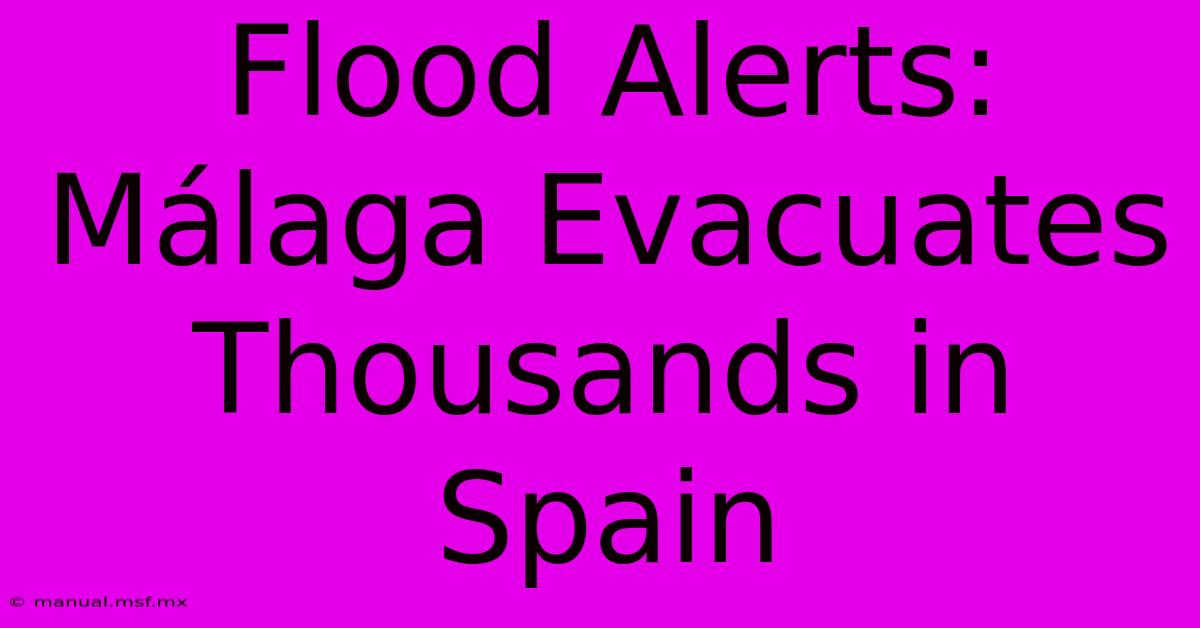Flood Alerts: Málaga Evacuates Thousands In Spain

Discover more detailed and exciting information on our website. Click the link below to start your adventure: Visit Best Website. Don't miss out!
Table of Contents
Flood Alerts: Málaga Evacuates Thousands in Spain - A Look at the Recent Heavy Rainfall and Its Impact
Have you ever wondered how extreme weather events can bring about widespread evacuations? Flood alerts in Málaga, Spain, have recently led to the evacuation of thousands of residents, highlighting the devastating impact of heavy rainfall. This situation underscores the critical importance of preparedness and proactive measures in the face of such natural disasters.
Editor Note: Flood alerts in Málaga, Spain, have resulted in the evacuation of thousands of residents.
Understanding the severity of this situation is crucial, as it sheds light on the vulnerability of coastal regions to extreme weather events. This article will delve into the recent floods in Málaga, examining the factors contributing to the heavy rainfall, analyzing the impact of the floods, and exploring the measures taken to mitigate the situation.
Analysis: This exploration of the Málaga floods is based on data gathered from reputable news sources, official reports from Spanish authorities, and expert analyses on climate change and its impact on extreme weather events.
Key Takeaways of Flood Alerts in Málaga
| Key Aspect | Description |
|---|---|
| Heavy Rainfall | Record rainfall exceeding historical averages triggered the flood warnings. |
| Evacuations | Thousands of residents were evacuated from coastal areas and low-lying regions. |
| Infrastructure | Roads and buildings suffered damage, disrupting essential services and transportation. |
| Response | Emergency services deployed resources to evacuate residents and manage the aftermath. |
Flood Alerts in Málaga: A Deeper Dive
Heavy Rainfall: The recent flood alerts in Málaga were triggered by an unprecedented amount of rainfall. The region experienced several days of intense downpours, far exceeding historical averages. This heavy rainfall overwhelmed drainage systems, leading to widespread flooding.
Evacuations: Faced with the rising floodwater, authorities ordered mandatory evacuations in coastal areas and low-lying regions. Thousands of residents were forced to leave their homes, seeking shelter in temporary evacuation centers.
Infrastructure: The impact of the floods extended beyond residential areas, causing significant damage to infrastructure. Roads were flooded, making transportation difficult, and buildings suffered water damage, impacting essential services. This disruption caused economic losses and further compounded the difficulties faced by affected residents.
Response: The Spanish government deployed emergency services, including firefighters, police, and rescue teams, to manage the situation. These teams were tasked with evacuating residents, securing critical infrastructure, and providing assistance to those affected by the floods.
The Connection between Climate Change and Floods
The recent floods in Málaga serve as a stark reminder of the potential consequences of climate change. While it is difficult to attribute any specific weather event directly to climate change, the increasing frequency and intensity of extreme weather events worldwide are consistent with climate change projections.
FAQs by Flood Alerts in Málaga
Q: What caused the floods in Málaga?
A: The floods were primarily caused by unusually heavy rainfall that overwhelmed drainage systems.
Q: How many people were evacuated?
**A: ** Thousands of residents were evacuated from coastal areas and low-lying regions.
Q: What impact did the floods have on infrastructure?
A: Roads and buildings were damaged, disrupting transportation and essential services.
Q: What measures were taken to mitigate the floods?
A: Emergency services were deployed to evacuate residents, secure critical infrastructure, and provide assistance.
Q: How can climate change contribute to such floods?
A: While it is difficult to attribute any specific weather event directly to climate change, the increasing frequency and intensity of extreme weather events worldwide are consistent with climate change projections.
Tips for Flood Prevention and Mitigation
1. Stay informed: Monitor weather forecasts and alerts from local authorities.
2. Prepare a flood emergency kit: Include essentials like water, food, first-aid supplies, and important documents.
3. Raise belongings: Store valuable items above potential flood levels.
4. Know your evacuation routes: Familiarize yourself with the designated evacuation routes for your area.
5. Consider flood insurance: Protect your property from financial losses due to flood damage.
Summary by Flood Alerts in Málaga
The recent floods in Málaga serve as a potent reminder of the vulnerability of coastal regions to extreme weather events. While the immediate focus is on recovering from the floods and helping those affected, this incident highlights the need for ongoing efforts to mitigate the impacts of climate change and improve disaster preparedness measures.
Closing Message: As we navigate the increasingly unpredictable climate landscape, understanding the potential for extreme weather events and prioritizing preparedness measures is crucial. The Málaga floods serve as a stark reminder of the need for community resilience, continuous adaptation, and a collective commitment to mitigating climate change's effects.

Thank you for visiting our website wich cover about Flood Alerts: Málaga Evacuates Thousands In Spain. We hope the information provided has been useful to you. Feel free to contact us if you have any questions or need further assistance. See you next time and dont miss to bookmark.
Also read the following articles
| Article Title | Date |
|---|---|
| Frosinone Rissa In Piazza Pertini Due Feriti Gravi | Nov 14, 2024 |
| Enterro Da Anistia Repercussao Apos Ataques | Nov 14, 2024 |
| Gentilezza Un Antidoto Ai Mali Di Oggi | Nov 14, 2024 |
| 2 43 B Carboxymethyl Cellulose Market Forecast | Nov 14, 2024 |
| Fans Jubeln Braunschweig Zurueck In Der Bundesliga | Nov 14, 2024 |
| Chaumont Verliest Tie Break In Lueneburg | Nov 14, 2024 |
| Esslingen Brand Mit Todesfolge Loescharbeiten Dauern An | Nov 14, 2024 |
| Gaetzs Justice Department Nomination Under Scrutiny | Nov 14, 2024 |
| Australien Neuer Trainer Gegen Saudi Arabien | Nov 14, 2024 |
| Tyson Vs Paul Fight Stats And Analysis | Nov 14, 2024 |
